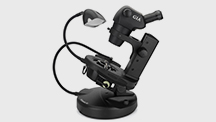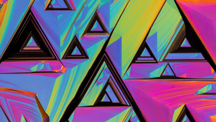A “Hollow” Pearl Filled with Foreign Materials

The interior structures of pearls are always of interest, as they are never revealed until the analysis begins. External appearance may provide experienced pearl testers with some clues on what to expect when microradiography commences, but sometimes the structure revealed is beyond expectation (Spring 2014 Lab Notes, pp. 66–67; Winter 2015 Lab Notes, pp. 434–436).

In early 2019, a semi-baroque white and cream pearl, weighing 28.49 ct and measuring 19.23 × 16.44 × 15.05 mm (figure 1), was submitted to GIA’s Bangkok laboratory. Its external appearance and size gave no obvious preliminary clues about its identity. A fairly small oval area on the base measuring approximately 5.20 × 3.10 mm differed in appearance from the rest of the pearl. Initial examination with a loupe and microscope revealed that the pearl’s surface had been worked and heavily polished, producing a lustrous appearance. Many surface areas had been modified, including the small oval area already mentioned. More detailed observation using a stereomicroscope revealed foreign materials within the yellow-brown area on the base (figure 2), including a piece of shell-like material (figure 2B and 2C, red arrows) together with other random fragments within a transparent light yellow substance enclosing several gas bubbles (figure 2D, blue arrows). Similar features were observed in the filler material used in natural blisters previously submitted to GIA (Summer 2016 Lab Notes, pp. 192–194). Although the surface structure indicated that the pearl was most likely filled with foreign materials, such an assumption could only be proved after more detailed study.

Real-time microradiography (RTX) and X-ray computed microtomography (μ-CT) revealed the pearl’s internal structure, including a large dark and fairly irregular outline that indicates the pearl was hollow at one time. RTX analysis (figure 3A) showed that some parts of the structure clearly reached the surface at the base. After RTX examination in a number of different orientations, however, it was very apparent that the structure was no longer hollow. Instead, it was completely filled with foreign materials, displayed as an array of disorderly fragments (figures 3A and 3B). The μ-CT images revealed clearer structures, with the outlines of fragments in various sizes apparently suspended in the former void. The μ-CT results also showed a degree of structural variance in the materials present within the filler. One off-round feature displayed an organic-rich ring at its center, with a very small white core possibly indicating the presence of a small natural seed pearl (figure 3C and 3D, blue arrows). Other irregular features with a similar radio-opacity seemed to be related to pieces of shell (as seen with the microscope at the surface of the filled area on the base), while an unidentified, more radio-translucent feature was also noted (figure 3D, red arrow). An additional small radio-opaque white impurity (likely a metal fragment) was observed in association with the latter and may be seen with all the other components in the supplemental μ-CT videos bellow.
The “hollow” form bears some similarity to previous cases, such as a natural hollow pearl (N. Sturman, “Pearls with unpleasant odors,” GIA Laboratory, Bangkok, 2009, www.giathai.net/pdf/Pearls_with_unpleasant_odours.pdf) or the voids seen in some non-bead cultured pearls (N. Sturman et al., “X-ray computed microtomography (μ-CT) structures of known natural and non-bead cultured Pinctada maxima pearls,” Proceedings of the 34th International Gemmological Conference, 2015, pp. 121–124). Nevertheless, we cannot be certain why this void was filled with a variety of materials. The most plausible reasons are that (A) the feature needed to be filled so the pearl could be used in jewelry, and a selection of natural “shell-related” materials were mixed with adhesive to achieve this goal, or (B) the process was carried out to add weight to the pearl so it could be sold for a higher price, or both.

The pearl’s fluorescence in the DiamondView was a strong blue, typical of many previously examined pearls. However, there was a degree of inhomogeneity that might be due to the surface condition (figure 4). The main reason to expose the pearl to the radiation of the DiamondView was to see how the materials in the filled area reacted. The results showed that the largest fragment and the pearl’s surface produced a similar reaction, which supports the possible presence of shell pieces. Other smaller constituents showed weaker reactions, and the surrounding transparent host exhibited a yellow-green reaction.
Raman spectroscopic analysis of the filler confirmed the presence of shell based on a match with aragonite spectra, which is characteristic of many mollusks and pearls. The transparent filler material produced spectra that closely matched with a polymer. The chemistry of the largest piece of shell visible at the filler’s surface was checked by energy-dispersive X-ray fluorescence (EDXRF) spectrometry and showed manganese (Mn) and strontium (Sr) levels characteristic of a saltwater environment.
Since the void within the pearl had been completely filled with foreign materials, it was unclear exactly what its original structure was prior to the work undertaken. Several scenarios are possible:
- The pearl contained natural organic matter and formed naturally.
- It had a large void with some organic matter in it, typical of some non-bead cultured pearls.
- The large void contained a bead nucleus that was intentionally broken and mixed with bonding material and other components to fill the void and mask the identity, or the pieces of broken bead were removed before the void was filled with shell and other materials.
Where doubt about the actual identity exists and each possibility has merit, it is unfair to the client to simply make an educated guess. After explaining the situation to the client, we left the identity of this pearl as “filled” but of an “undetermined” origin (natural, bead cultured, or non-bead cultured). Accordingly, a report was not issued.



